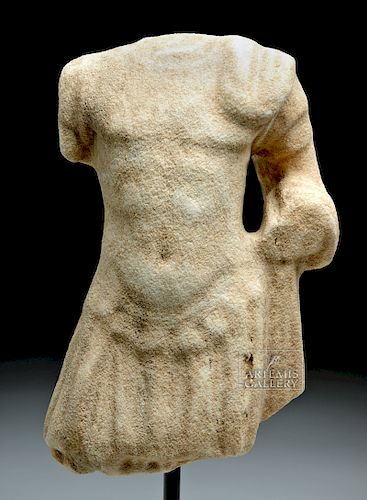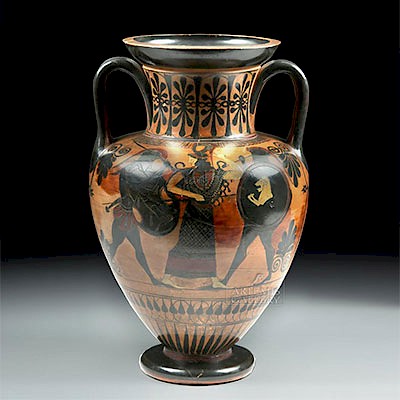Roman Marble Torso of Mars in Military Attire
Lot 29
About Seller
Artemis Gallery
686 S Taylor Ave, Ste 106
Louisville, CO 80027
United States
Selling antiquities, ancient and ethnographic art online since 1993, Artemis Gallery specializes in Classical Antiquities (Egyptian, Greek, Roman, Near Eastern), Asian, Pre-Columbian, African / Tribal / Oceanographic art. Our extensive inventory includes pottery, stone, metal, wood, glass and textil...Read more
Estimate:
$6,000 - $10,000
Absentee vs Live bid
Two ways to bid:
- Leave a max absentee bid and the platform will bid on your behalf up to your maximum bid during the live auction.
- Bid live during the auction and your bids will be submitted real-time to the auctioneer.
Bid Increments
| Price | Bid Increment |
|---|---|
| $0 | $25 |
| $300 | $50 |
| $1,000 | $100 |
| $2,000 | $250 |
| $5,000 | $500 |
| $10,000 | $1,000 |
| $20,000 | $2,500 |
| $50,000 | $5,000 |
| $100,000 | $10,000 |
| $200,000 | $20,000 |
About Auction
By Artemis Gallery
Oct 11, 2018
Set Reminder
2018-10-11 10:00:00
2018-10-11 10:00:00
America/New_York
Bidsquare
Bidsquare : Exceptional Antiquities | Ethnographic Art
https://www.bidsquare.com/auctions/artemis-gallery/exceptional-antiquities-ethnographic-art-3500
An important one-day auction featuring museum-worthy examples of classical antiquities, ancient and ethnographic art from cultures encompassing the globe. Artemis Gallery info@artemisgallery.com
An important one-day auction featuring museum-worthy examples of classical antiquities, ancient and ethnographic art from cultures encompassing the globe. Artemis Gallery info@artemisgallery.com
- Lot Description
Roman, Imperial Period, ca. 1st to 3rd century CE. A half-size carved marble torso of Mars (Greek Ares), the God of War, donning a paludamentum (a cloak or cape worn by military commanders and emperors) with voluminous folds of drapery cascading from his left shoulder and held in the crook of his left elbow - and a short billowing pterubes (a skirt made of fabric or leather strips and worn around the waist) with a cingulum militare (a decorative belt denoting the wearer's rank) of roundels falling just below his abdominals. Otherwise, he is bare-chested, thus allowing the sculptor's prowess for delineating musculature and anatomy to shine. Size: 11.625" H (29.5 cm); 17.875" H (45.4 cm) on included custom stand.
Mars (Greek Ares) was the god of war - son to Jupiter and Juno (Greek Zeus and Hera) and one of the Twelve Olympians. His sister Minerva (Greek Athena) was the goddess of war. Whereas Mars traditionally represents the fiery, violent aspects of combat, his sister Minerva/Athena usually represents intellectual military strategy.
In Ancient Rome, the paludamentum served as a cloak for generals and emperors. Reliefs on Trajan's column and sculptures of numerous cuirassed leaders include depictions of paludamentum. This special garment was traditionally dyed scarlet or purple or bleached white, and must have made quite an impression, especially given that it was traditionally worn when venturing out to or returning from war. The paludamentum symbolized legitimate authority as well as honor. Demonstrating this, Marc Antony ordered that Brutus be cremated while wearing his.
Provenance: private East Coast, USA collection
All items legal to buy/sell under U.S. Statute covering cultural patrimony Code 2600, CHAPTER 14, and are guaranteed to be as described or your money back.
A Certificate of Authenticity will accompany all winning bids.
We ship worldwide and handle all shipping in-house for your convenience.
#137809A section from a larger statue with losses to limbs, neck, and head as shown. Earth deposits and expected surface wear commensurate with age.Condition
- Shipping Info
-
All shipping is handled in-house for your convenience. Your invoice from Artemis Gallery will include shipping calculation instructions. If in doubt, please inquire BEFORE bidding for estimated shipping costs for individual items.
-
- Buyer's Premium



 EUR
EUR CAD
CAD AUD
AUD GBP
GBP MXN
MXN HKD
HKD CNY
CNY MYR
MYR SEK
SEK SGD
SGD CHF
CHF THB
THB














